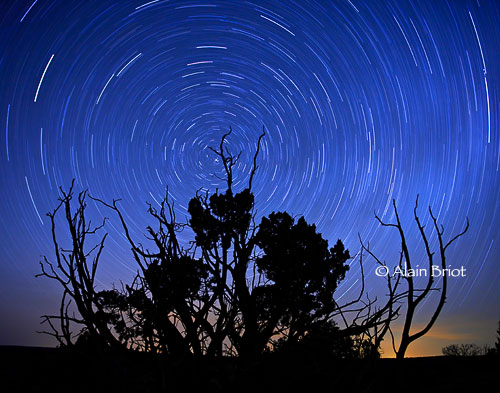By Alain Briot

This photograph was taken in an area of Navajoland called theNew Lands. It is located the furthest South of any area in Navajoland. In this instance, looking at a map of Arizona, this location is about 100 miles north of St Johns and 40 miles south of Sanders. Neither town is very well known. To use a better-known landmark, the new lands are south of I-40, the interstate that runs East-West in Northern Arizona, roughly following the path previously chosen for old US 66.
The New Lands are the result of the Navajo-Hopi land dispute. The Hopi, whose relatively small reservation is located square in the middle of the much larger Navajo Reservation, have contested the exact boundaries of their reservation for years on the basis that the boundaries of their land were established first, and that the Navajo settled in Arizona long after the Hopi. In the 1940’s, as a result of this dispute, a certain acreage of Navajo lands was turned over to the Hopi and became part of the Hopi Reservation. As part of this arrangement the Arizona government gave an equal amount of land to the Navajo. This land, located south of the previous Navajo Reservation boundary, came to be known as the New Lands. In turn, a new type of Navajo Rug design surfaced, which came to be known as the New Lands Style. Promoted by theBurnham TradingPost in Sanders, Arizona, this design is characterized by vivid colors and the inclusion of multiple designs on one rug, each design being featured inside a rectangle approximately 12”x15”.
Because the New Lands feature no National Park, National Monument or other publicly accessible natural areas, photographing there is a challenge. Most of the land is fenced, inhabited or otherwise inaccessible. The exact location of this photograph is actually a couple of miles south of the New Lands boundary, on a property that I personally own. Because the landscape is virtually identical to that found on the actual Navajoland reservation, and because it is nearly impossible to photograph in the New Lands, especially at night, this is as close as any non-native can get to photograph this part of Navajoland.
This image originated as an idea. I visualized this tree outlined upon a starry night sky, each star rotating around Polaris. I had owned this property for over 5 years prior to creating this image, and therefore was intimately familiar with the shape of this tree. In fact, I had photographed it, and others similar to it, on several occasions. However, each of my previous attempts were made either at sunrise, at sunset or during daytime, and while some of the images were quite pleasing, they did not catch the spiritual feeling that I associate with this place.
In this instance I traveled to the New Lands for the sole purpose of creating this image. The location is about 350 miles from where I live, so making the trip, photographing and returning home is a multi-day affair. I decided to use the Canon 1DsMk2 for this image, in large part because I was curious about the image quality of a very long digital night exposure.


In preparation for creating this image I purchased the Canon TC80N3 Timer Remote Control, which I would need to do a timed long exposure. I planned to do a 1 hr exposure, on the basis of the camera battery life. The 1DsMk2 has a very long battery life, sometimes lasting as long as 5 days under normal use until it has to be recharged or replaced by a spare, but a night exposure is a special endeavor. With any exposure lasting longer than 10 seconds (approximately) the camera creates a “dark frame” of the same exposure length, then compares it to the exposed image to remove noise and “hot pixels” (pixels that are rendered pure white), both unwanted digital artifacts that show up on long digital exposures. This approach, which is automatic and cannot be cancelled, means that a 1hr exposure becomes a 2hr exposure, thereby severely taxing the camera’s battery life. A 2hr continuous exposure is just about the limit of the 1DsMk2 battery life. With cameras using less powerful batteries, the maximum exposure may be as short as 15 minutes or even less. With this type of images – long exposures at night done with a digital camera — the maximum length of the exposure is controlled by the camera’s battery life and not by the will or the inspiration of the photographer
This was my first attempt at a night photograph in a long time and because of that I faced numerous challenges due to lack of practice. On top of that, I had chosen a moonless night because this was the only way to get a very dark sky and no light onto the tree. Finally, I did not start setting up the camera until it was dark, making the task of composing the image precisely extremely challenging. I had to use a flashlight to illuminate parts of the tree to know where the borders of the image were located.
I did know that the tree faced Polaris from using a compass and that helped. However, I was aware that I needed to position the camera low and pointing up in order to not only get Polaris in the frame but also to have the star in the mid-upper part of the image and not at the very top.
The tree I had chosen is located on a sandy bluff with a small drop off in front of it. This location was ideal for this shoot since it allowed me to position the camera in the drop off area in front of the tree and thereby shoot the tree from below, looking up. However, the sandy bluff meant that there was a risk the sand would shift during the 1hr exposure and thereby cause the camera and tripod assembly to move. To prevent this I pushed the tripod legs into the sand as firmly as I could after I positioned the camera where I wanted it.
I then set the timer for a 1hr exposure, set the camera exposure mode to “bulb” and opened the shutter to f 5.6, enough to generate the minor depth of field that I needed to get the near and far tree branches sharp. I set the ISO to 100. A higher ISO would have resulted in more noise for no added benefit: I did not need a high shutter speed since I was exposing for 1 hr, the camera was set to “bulb” (continuous exposure) and the camera was on a tripod. The stars would have plenty of time to register on the digital file over the 1 hr exposure and I did not expect to get details in the tree branches that, at any rate, I intended to render as pure black. Finally, with all this taken care of, I released the shutter then stepped back cautiously to prevent moving the sand around the tripod.
I am sometimes asked why the stars register as trails on such a photograph and not as points of light as we see them with our own eyes. The answer is that the earth turns around its axis, taking 24hrs to complete a rotation, while the stars are either immobile, or their movement is unnoticeable. It is the rotation of the earth that causes the stars to streak, while the elements in front of the stars remain sharp. This effect is similar to how a passing car would register as streaked head and taillight to a camera mounted on a tripod and set to an exposure of several seconds, while the buildings behind the car would be sharp.
I have also been asked why the tree is pure black, although the 1 hr exposure should have brightened its color or brought out some details. Scott McLeay, my first photography teacher, explained it best by saying that if you lock yourself in a closet without any source of light with your camera and expose the film for several hours, you will get nothing on film no matter how long your expose is because there is no available light whatsoever. What matters, in regards to getting details or color on film or on a digital sensor, is not how long your exposure is. What matters is whether there is light available or not. In the case of this image, the only light is that of the stars, a light too faint and too distant to actually shine onto the tree.
I am walking in the darkness of this moonless night, following the edge of the sandy bluff that borders my property to the West. In front of me is the tree whose familiar shape at this time is barely visible, its branches merging with the near-black sky. The valley behind it and the bluff on the other side are invisible. The stars above are tight points of light.
I try to reconciliate what my eyes faintly see with the image in my mind, imagining a dark blue sky behind sharply delineated branches with stars swirling around Polaris. I feel I am writing a poem that the camera somehow will record and that I will, later, re-write in the solitude of my digital darkroom.
In this type of photograph it is important to keep track of the time you start the exposure so you know when it is finished. This is especially important with film because you leave the shutter open all night long and you must close it before dawn otherwise the upcoming sunrise will wash out the star trails and cause overexposure. With digital captures the camera will stop on its own, however, the thought of leaving a $10,000 camera all by itself in the wilderness, even on my own property, wasn’t reassuring and I wanted to make sure to get it back as soon as possible.
Because of the many new variables I was dealing with I was unsure of what the resulting image would look like. However, as it turned out my first attempt was right on. The composition, the exposure, the star trail, all combined to create what appeared to be a fantastic image, even when seen on the camera’s small LCD screen.
Not sure if this was the best image I could create, I tried different composition with other trees during the next two nights. However, as luck would have it, these subsequent attempts did not even come close to my original image which was based on my pre-visualization for this scene, a pre-visualization that turned out to be amazingly close to the final image.
In the studio I was pleasantly surprised at the very low level of noise in the image. I was expecting a rather noise-filled image, especially in the even-toned sky areas. However, the image featured smooth, even tones. The ISO 100 setting combined with the dark frame removal had worked wonders.
The most important decision I made in the studio was to adjust the color of the sky. On a moonless night, to our eyes, the sky appears black. I had chosen “Auto White Balance” for this exposure, as I almost always do with natural light, preferring to let the camera pick the white balance and then modify this setting to fit my taste later on. As a result, the sky was rendered slightly yellow on the digital file, as it often is with long digital night exposures. However, my personal memory of the scene was of a cool, dark blue sky. I therefore adjusted the white balance during raw conversion to match the blue I remembered seeing, and which to me best depicted this scene as I experienced it. In Photoshop, I further saturated and adjusted this blue until it was exactly the color I wanted it. I also adjusted the black point so that the tree branches are rendered pure black.
If you look at the histogram of such an image, you will see clipping in the shadows and the highlights. This is perfectly normal since the shadows are pure black and since some of the highlights –some of the star trails in this instance—are pure white. This is not a situation where we want, or can, get details everywhere. However, I was pleased to see that a lot of the star trails retained color, some reddish, others yellow, thereby providing a variation in the color and the intensity of the many star trails.
Alain Briot
Arizona
April 2007
I lead workshops to Navajoland several times each year. My current workshops listing is available on my website at http://www.beautiful-landscape.com I look forward to your comments on this essay. I encourage you to email atalain@beautiful-landscape.com
__________________________________________________________________________ The Gear, Software and Equipment I Used to Create this Image
Camera: Canon 1DsMK2 + spare battery
Lens: Canon 17-40 zoom set at 30mm
Filters: none
Exposure: 1hour at f. 5.6
White balance: Auto
Exposure mode: bulb and manual f-stop setting
Mirror lockup: No.
Accessories: Canon TC80N3 Timer Remote Control
Tripod: Gitzo 2228 Carbon Fiber tripod
Ballhead: Really Right Stuff 55 ballhead with quick release plate
Raw Converter: Capture One Pro
Image Processing: Photoshop CS2
Printer: Epson 4800 with ImagePrint 6.1 + Phatte Black
Paper: Crane Museo Silver Rag
You May Also Enjoy...
ps-and-ls
Strange Title? What Does it Mean? We all learned the 3 "R"s in grade school.Readin,writinand'rithmatic. But what are the 3 L's and the 3 P's
Wind River Range
"Mohammed made the people believe that he would call a mountain to him, and from the top of it offer up his prayers for the
